all of the telescopic discoveries for which Galileo is famous were made independently by other observers in the same period and if he had never existed it would have made little or no difference to the development of telescopic astronomy.What Galileo was especially good at was seizing credit and virulently attacking anyone who contested with him. A summary of the essays at The Renaissance Mathematicus plus other material from the Galileo Project follows. The Renaissance Mathematicus site is a marvelous one for anyone interested in the history of science. The more detailed essays can be found at the links below.
The sunspot controversy: Spotting the Spots
The moons of Jupiter controversy: One Day Later
The Sunspots -- A Chronology
Chinese, Islamic and medieval European observers had noted and recorded sunspots by naked eye observations over the centuries. But these had no impact on the development of astronomy. Astronomers back then were interested in the motions of celestial bodies and not their physical properties. Astronomy in the West was not even considered part of physics, but as a part of mathematics. In China, it was simply arithmetic. Also, the sun was considered to be pristine and so the sunspots were seen as clouds, planets, et al.
Some noted sightings include:
467 BC. Anaxagoras appears to have observed a sunspot.
364 BC. Gan De, based on comments in a star catalogue, appears to have spotted a sunspot.
28 BC et seq. Chinese astronomers regularly record sunspot observations in imperial records.
AD 807. 17 March. The Benedictine monk Adelmus observes a large sunspot which was visible for eight days. He concluded incorrectly that it was a transit of Mercury.
AD 813. A large sunspot is seen at the time of Charlemagne's death.
AD 1129. John of Worcester describes sunspot activity.
Late 12th cent. Ibn Rushd provides a description of sunspots.
+ + +
AD 1607. Using a camera obscura, Johannes Kepler observed an especially large sunspot. But he thought it was a transit of Mercury which was happening at the same time. (It was Kepler who coined the term camera obscura.)
 |
| Galilean telescope, typical of the times. |
Eyeball astronomy could not make the sort of quantifiable observations of the sun that the new physical astronomy would demand. In AD 1608, the Dutchman Jean Lippersheim of Middelbourg invents the telescope and the race was on in the "look-see-gosh-wow" era of astronomy. In the early 1610s, four men deliberately turned their telescopes to the sun and each in a way has a "first" to his name. They are Thomas Harriot, Englishman, who first observed and recorded sunspots telescopically; Johann Fabricius, Frisian, who first published an account of the sunspots; Galileo Galilei, Italian, who first proved rigorously the nature of the sunspots (confirming an intuition of Fabricius'); and Christoph Scheiner, SJ, German, who devised the method of recording sunspot changes over time and measured and discovered the differential rotation of the sun. Of them, only Scheiner and Galileo were aware of each other's work, and engaged in a pamphlet war for which the term "cross-posting" had not yet been invented. It seems clear to historians now that all four men were making their observations within a few months span of one another. When it's time to railroad, people start railroading.
Complicating the priority question is the fact that dual calendars were then in use: the Julian calendar in Protestant countries and the more correct Gregorian calendar in Catholic countries.
 |
| Thomas Harriot |
AD 1609. Harriot begins making telescopic observations. His Moon drawing (early August) is the first on record and precedes Galileo's study of the Moon by several months.
AD 1610. Christoph Scheiner SJ is teaching Hebrew and mathematics (physics and astronomy) in Ingolstadt. He lectures on sun dials, practical geometry, astronomy, optics and the telescope. After hearing of Galileo's initial discoveries with the telescope, he immediately sets out to obtain good telescopes with which to scrutinize the heavens. He verifies Galileo's discoveries of the Lunar mountains and Jovian moons, and heaps praises on him.
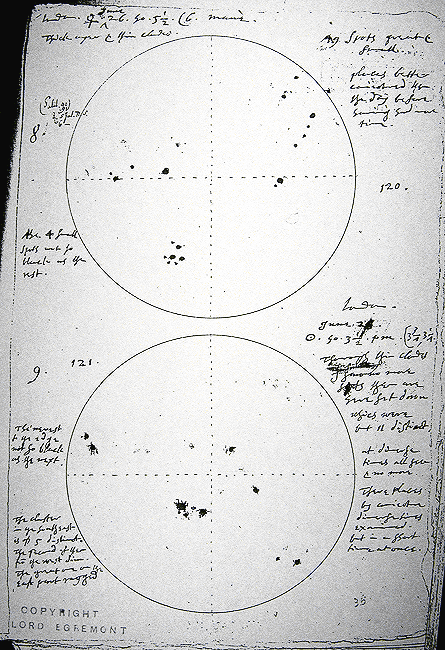 |
| Harriot's notes on the sunspots |
AD 1610. December. Harriot observes sunspots and makes a record (see right). He shares the observations with a group of correspondents in England, but does not publish them.
 |
| Johann Fabricius |
AD 1611, 27 February (9 March in Catholic lands), at dawn. Johannes Fabricius directs the telescope at the rising sun and sees several dark spots on it. He calls his father, and together the two investigate this phenomenon. They direct their instruments to the edge of the Sun, and when their eyes adjust to the brightness slowly move toward the Sun's center. This method is rather painful, and the two quickly switch to a camera obscura.
Over the next several months they track spots across the Sun's face and find that a dozen or so days after they disappear from the western edge of the Sun they reappear on the eastern edge. Hmmm.
AD 1611, March/April. Christoph Scheiner in Ingolstadt observes sunspots using a telescope filtered with colored glass
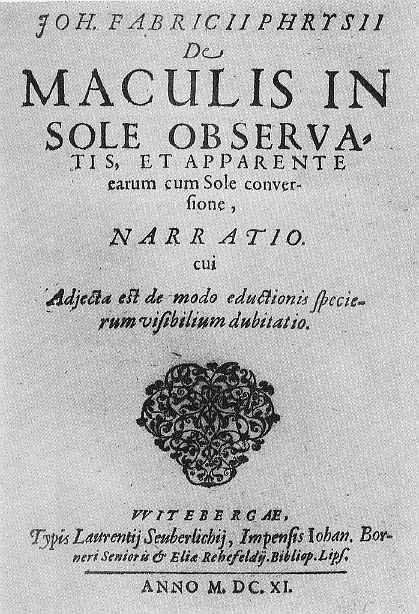 | |
| Pamphlet of Johann (& D) Fabricius It contained no drawings or data |
AD 1611, December. David Fabricius (the father) writes to Michael Maestlin (Kepler's old teacher) that he disagrees with his son and does not believe the spots were actually on the Sun's body, although the center of their motions clearly lay in the Sun.
Christoph Scheiner AD 1611, October. Scheiner (right) begins his systematic study of sunspots. He writes of his discoveries in a series of letters to Marcus Welser, the wealthy Augsburg banker, scholar, and patron of science. Welser immediately sends copies to Galileo, asking for his comments.
The Pamphlet War
 |
| Depiction of sunspots by Christoph Scheiner, SJ His method of depiction became the standard. |
Recall that physics was then distinct from the mathematical field of astronomy. The physicists said that the sun was perfect, so Scheiner interpreted sunspots as caused by satellites of the Sun whose shadows were projected on to Sun's disk as they cross in front of it, but were invisible at other points in their orbits. Their orbits had to be very close to the Sun for their shapes were foreshortened as they approached its edge.
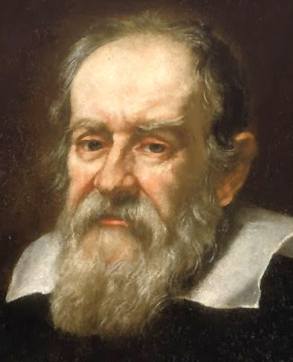 |
| Galileo Galilei |
AD 1612, April. Galileo begins his systematic study of sunspots. He is assisted by his protégé Benedetto Castelli, who is then in Florence. (Castelli develops a method of projecting the Sun's image through the telescope, which makes it possible to study the Sun in detail even when it was high in the sky. Father Castelli succeeded to Galileo's chair at Pisa and one of his students will be Torricelli. It will be a letter to Fr. Castelli that gets Galileo in deep doo-doo later on.) Galileo writes his first letter to Welser on sunspots, arguing that the spots are on the surface of the Sun or in its atmosphere, and although he cannot say for certain what they are, they appear to him most like clouds.
While Scheiner writes in Latin, the international language, Galileo has written his letter in Italian, and Welser must have it translated before Scheiner can read it. Meanwhile, Scheiner continues his solar observations, and so by the time he has mastered Galileo's letter he has already finished two more letters of his own to Welser. He now adds a third, in which he comments that his observations agreed precisely with those of Galileo but defends his judgment that sunspots are solar satellites. So far, both theories seem to fit the data.
AD 1612, August. Galileo writes a second letter to Welser in which he shows a large number of sunspot observations, each made at roughly the same time of the day, so that the Sun's orientation is the same and the motion of the spots across its disk can be easily followed. This was a clever move in observational methodology.
AD 1612, October. Welser publishes Scheiner's second series of letters under the title De Maculis Solaribus . . . Accuratior Disquisitio ("A More Accurate Disquisition . . . on Sunspots"). Scheiner maintains his pseudonym of Apelles... "or, if you prefer, Odysseus under the shield of Ajax." Those late Renaissance/Early Modern folks were nuts about strewing classical allusions into everything.
AD 1612, December. Upon receiving Scheiner's second tract Galileo writes yet a third, attacking Apelles's opinions once again. You will notice that they are cross-posting. Galileo has just read a pamphlet written before his own most recent letter and therefore not cognizant of the contents of that letter.
AD 1613, Summer. Galileo's three letters are published in Rome by the Lyncean Academy (of which he is a star member). About a third of the copies contain reprints (in their original Latin) of the two three-letter tracts by "Apelles" (whose secret identity has in the meantime been revealed). No contest. Scheiner's language is convoluted and in Latin, while Galileo is colloquial and amusingly polemical. But not only did Galileo demolish Scheiner's argument, he also criticized Scheiner's a priori method of argument: the Sun is perfect, therefore it cannot have spots on its surface. Galileo could never let anyone disagree with him without calling him stupid. That the Sun is perfect was the "consensus science" of the physicists, and mere mathematicians (astronomers) had no place to disagree. But part of the revolution is that astronomy is shifting over from the math department to the physics department, and neither physicists nor astronomers are quite in their new roles yet. We cannot fault Scheiner as foolish for accepting the consensus physics of the past couple thousand years. What we can do is admire him when, convinced by Galileo's mathematical analysis of the spots, he changed his mind and agreed. Now, that's a scientist!
The proof that convinced Scheiner: The points A, B, and C (above) are at equal distances apart on the surface of the Sun. Assuming the Sun rotates at a constant rate, the letters represent positions of a sunspot at equal intervals of time. From your perspective on Earth, the spot moving from A to B only goes a little ways, so appears to move slowly. On the other hand, the spot moving from B to C covers a lot of ground, and appears to move rapidly.
If the spot were a planet revolving some distance away from the Sun, it's speed would not appear much different as the planet went past the limb and then across the center of the Sun's image. This not only showed that the model accounted for the observation, but the other model did not.
In those days, the method of composition and resolution (or demonstrative regress) demanded that not only did you need to develop a theory T that accounted for the observations O, but you had to show that only T could account for them.
Up to this point, Galileo and Scheiner have been friendly. Scheiner had treated Galileo with great respect, and Galileo had been courteous in his language. But Galileo's attacks began to evoke counter-attacks and enmity between them grew.
AD 1616. Johannes Fabricius dies, his pamphlet still relatively unknown. He should have sent it to Marcus Welser.
AD 1616/1617. Christoph Scheiner leaves Ingolstadt and joins the Roman College.
Aftermath
AD 1623. Galileo publishes The Assayer. In it, he complains about those who would steal his priority of discovery, mentioning the case of sunspots but not mentioning Scheiner specifically. Scheiner takes the complaint to be directed at him and becomes extremely hostile to Galileo thereafter. Ironically, The Assayer attacks fellow-Jesuit Grassi over the Comets of 1618. Grassi, who had observed them meticulously, concluded that they were on non-circular orbits from beyond the Moon. This upset the Copernican system of circular orbits. Galileo, who had not observed them, claimed they were obviously emanations in the Earth's atmosphere. Then he heaped ridicule on Grassi and wrote an otherwise inspiring essay on the scientific method.
Later, when Galileo has managed to insult his old friend and defender, the Pope, and gets in the aforesaid deep doo-doo, Scheiner, Grassi, and the other Jesuit astronomers will sit on their hands, even though by then most of them (including Clavius) were well-disposed to the Copernican system.
AD 1630. Scheiner publishes Rosa Ursini ("The Rose of Orsini"). This will become the standard text on sunspots for over a century. In it, Sheiner still maintains that he is the discoverer of sunspots, but has abandoned the perfection of the heavens and his opinion that the spots are solar satellites (giving due credit on this point to Galileo, whom he otherwise insults.) Scheiner's method of illustrating the motion of individual spots across the face of the Sun became the standard way of rendering this motion and the changing shapes of the spots. Galileo had confirmed Fabricius' interpretation that the spots were located on the surface of a rotating sun, as revealed by the foreshortening effect when they near the limb. In the Rosa, Scheiner takes it a step further: by measuring the rotation period with higher precision, he is able to show that the spots farther from the equator move more slowly, thus establishing the sun's differential rotation, now believed to be the source of the sunspots.
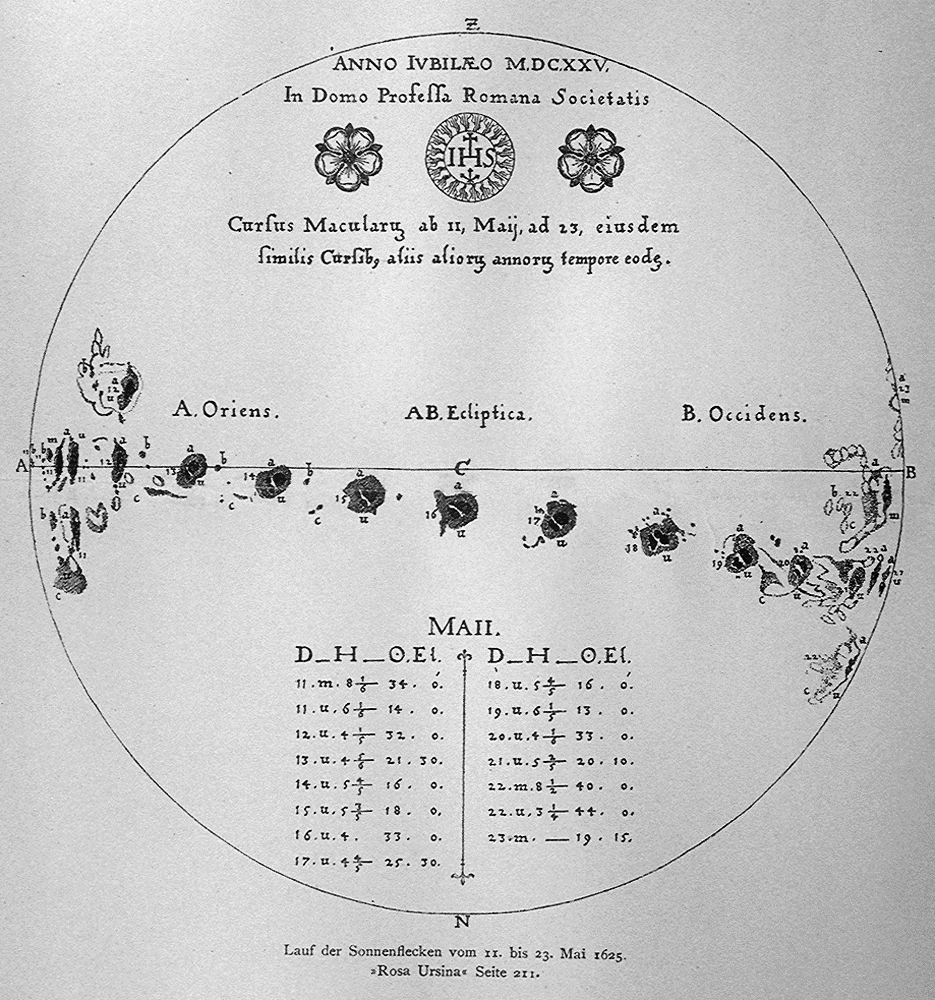 |
| Sunspot record from Scheiner's Rosa Ursini |
Meanwhile....
AD 1627. Thomas Harriot dies. The executors of his estate publish a small portion of his mathematical work under the title Artis Analyticae Praxis. Eventually, everyone will realize that he had been the first to telescopically study sunspots.
Fabricius has also died, but eventually everyone will realize that he was the first to publish. Kepler is the first to give him credit.
Other pertinent essays at the Renaissance Mathematicus:
Putting Galileo in his proper place in the history of science.
Cassini was the Real Founder of Telescopic Astronomy

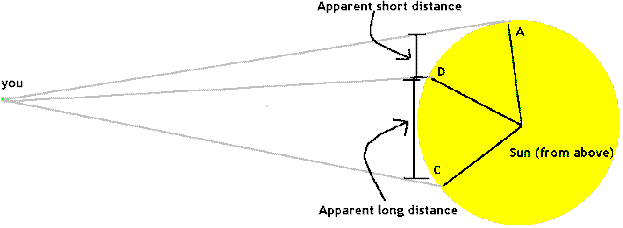


No comments:
Post a Comment